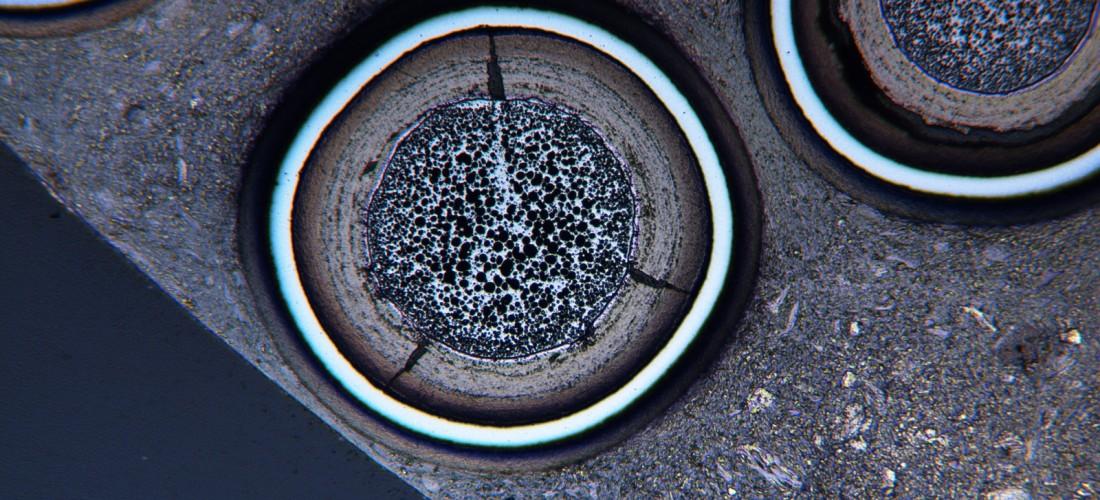
Individual TRISO fuel particles at 100um scale. (Credit: Idaho National Laboratory)
The long hunt for the location of a rare element within nuclear fuel particles is now finished. Researchers at Idaho National Laboratory have finally spotted where silver amasses inside irradiated particles of a new type of nuclear fuel. The finding will help scientists to further their understanding of how some fission products such as silver can escape from tristructural isotropic (TRISO) fuel. This specialized fuel could run pebble bed reactors and high-temperature gas-cooled reactors (HTGRs) that have numerous enhanced safety features.
“This is a major achievement for our research in TRISO particle fuel,” says David Petti, Idaho National Laboratory’s director of the Very High Temperature Reactor Technology Development Office. “Understanding the behavior of fission products in our fuel is critical because of the TRISO coating’s containment function in the overall safety strategy for HTGRs.”
Next-generation HTGR designs incorporate safety systems that rely on the natural laws of physics more than mechanical systems or human intervention. These safety systems extend all the way down to the design of the fuel itself.
For nearly 10 years, INL researchers have been studying TRISO fuel, a spherical particle with uranium dioxide or uranium oxycarbide at its core. The core is coated with layers of carbon and silicon carbide—the TRISO coating—which acts as “the primary containment” for fission products. The coated particles are about the size of a poppy seed.
Researchers had known silver fission products were amassing somewhere inside the coated particles. Silver is one of the few fission products that can migrate outside the particles, and scientists want to better understand such movement. But they had not been able to adequately “see” inside the particles until now. The research team reached the new milestone by spotting a tiny sliver of silver using an extremely powerful microscope at the Center for Advanced Energy Studies (CAES).
Scanning Transmission Electron Microscope (STEM) examination enabled 1-nanometer magnification, where the silver was identified and confirmed in the particle’s silicon carbide layer. Specifically, the silver resided along the “grain boundaries,” the place in a material where one crystal lattice ends and another begins. The STEM microscope helped confirm both the presence and location of the silver.
“The technique and scale of these measurements on TRISO fuel, as well as the identification of silver, are first-of-a-kind and are helping obtain a better understanding of the transport mechanisms associated with these fission products,” says Isabella van Rooyen, INL nuclear materials scientist and principal investigator for the research effort. For the past nearly 40 years, researchers have studied silver in the particles without finding a satisfactory explanation for its movement during and after irradiation.
This achievement was possible due to critical capabilities at INL to prepare very small irradiated specimens using the focused ion beam (FIB) at the Materials and Fuels Complex, the STEM at CAES, and the team’s supportive and innovative research approach. Only earlier this year, modifications to the CAES licensing agreement were approved by the Nuclear Regulatory Commission, allowing very small specimens with a low radiation dose to be examined at CAES, which was previously impossible. CAES is a research and education partnership between INL, Boise State University, Idaho State University and University of Idaho.
Now that the silver has been found, “the real fun begins,” Van Rooyen explains. It has been her dream to work on irradiated TRISO fuel and she says this discovery “opens the door for many future applications of TRISO fuel for both very high temperature reactors and small modular reactors.” Van Rooyen started the search for silver and the relevant transport mechanism in 2006 on nonirradiated fuel while working on pebble bed modular reactors in South Africa. That research brought her to INL in 2011, and she is pleased that in two short years the research is paying off.
Yaqiao Wu, a Boise State University research associate professor and instrument lead of Materials and Characterization Suite at CAES, echoes her excitement. “The expertise of the staff, researchers and the equipment at CAES played critical roles in making this discovery possible,” he said. “The smallest electron beam size with the STEM is around 1 nanometer, which is crucial for revealing the nanosized silver-rich phase in this particle.”
Fellow INL researcher Tom Lillo agreed, saying, “We are very fortunate to have state-of-the-art equipment and facilities to look at things that are happening on an extremely small scale in order to understand the behavior in large, advanced energy systems.”
The next step for the team is to continue to test and study the results. Team members say that more research is needed to identify the silver transport mechanism and to continue monitoring how the silver behaves.

